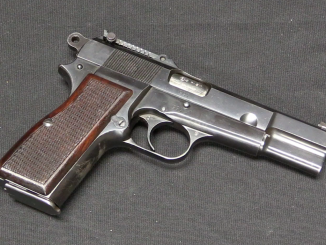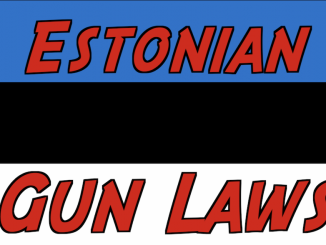When Estonia declared independence from Russia in 1918, it had no formal military. After winning a 2-year War of Independence, the nation needed to set up its own armed forces. The rifles available in Estonia were a mix of Mosin Nagants, Arisakas, Pattern 1914 Enfields, and German Mausers. The most common were the Mosins, and Mosins would form the bulk of Estonian arms until World War Two.
The initial Estonian military work was to refurbish, repair, and clean the Mosins it had, which resulted in about 40,000 good-quality rifles, plus another 64,000 purchased from the UK in 1922. Extensive military training took its toll though, and by the late 1920s many rifles were once again in poor shape. At the point, a project was established to make some improvements while still retaining the basic M91 Mosin form. This escalated to a major modification and rebuild program in the early 1930s.
The first model to be made was a marksman’s rifle, which a shorter and heavier barrel, better sights and a better trigger. Lessons from this work led to the development of the Model 1935 military short rifle, which is what we have today. Between 1935 and 1940 a total of 6,790 of these rifles were produced. Like the Finns, the Estonians only manufactured a few parts for the guns, taking receivers, bolts, magazines, and other small parts from their inventory of spares leftover from scrapped rifles in the early 1920s.
Unfortunately, the M1935 rifles never had a chance to see significant use, as Estonia had no real choice but to submit to Russian occupation in 1940.
Thanks to Texas Guns and Ammo for the loan of this rifle to film, and to my Estonian friend Aku for research assistance!



Mosin triggers can indeed be improved. I have a fare-thee-well hair trigger that someone managed in a sporterized Remington.
The root problem with the Baltic states is that they’re basically sitting there on the periphery in between a major imperial power and sea access, with zero defensible territory between them and the ports that the imperialists wanted.
I’m not sure how the hell you fix that, other than by moving your entire nation somewhere that is defensible, although I suppose you could do a whole bunch of geoengineering on your borders to create defensible terrain for yourself. What that would look like? No idea; might not even be possible.
I made friends with a guy who got out of Lithuania, back in the 1980s. His take on the whole thing was “Get out. Just… Get out.” His father, his uncles, his grandfather were all the Lithuanian equivalent of the “Forest Brothers”, and they all wound up dead. I think that out of seven males spread out over three generations, he was the only one who survived, and he only did it because his mother’s family managed to conceal his mother and he from the authorities. Him getting out of the then still-existent Soviet Union was apparently pretty epic, because he was still under oaths of secrecy to the UK and US governments when I knew him.
I always wondered what he did after the Wall came down.
You fix it with nukes. Is Vilnius worth Moscow or St Petersburg?
Arisakas were not acquired from Finnland, they were ex-Russian, just like Mosins (which have nothing to do with Nagant).
Weeeeeellllll… Aktually…
The reason that most Western sources refer to it as the “Mosin-Nagant” has a lot to do with Nagant’s chutzpah, and the Imperial Russian acquiescence to said ballsiness, as detailed here in Wikipedia:
https://en.wikipedia.org/wiki/Mosin%E2%80%93Nagant#legaldispute
“Despite the failure of Nagant’s rifle, he filed a patent suit, claiming he was entitled to the sum the winner was to receive. It appeared that Nagant was the first to apply for the international patent protection over the interrupter, although he borrowed it from Mosin’s design initially. Mosin could not apply for a patent since he was an officer of the Russian army, and the design of the rifle was owned by the Government and had the status of a military secret.
A scandal was about to burst out, with Nagant threatening he would not participate in trials held in Russia ever again and some officials proposing to expel Nagant from any further trials, as he borrowed the design of the interrupter after it was covered by the secrecy status given in Russia of that time to military inventions and therefore violated Russian law. Taking into consideration that Nagant was one of the few producers not engaged by competitive governments and generally eager to cooperate and share experience and technology, the Commission paid him a sum of 200,000 Russian rubles, equal to the premium that Mosin received as the winner. The rifle did not receive the name of Mosin, because of the personal decision taken by Tsar Alexander III, which was made based on the opinion of the Defence Minister Pyotr Vannovskiy: there are parts in this newly created design, invented by Colonel Rogovtzev, by Lt.-General Chagin’s Commission, Captain Mosin and small-arms manufacturer Nagant, therefore it is only fair to call it the Russian 3-line rifle M1891. The Tsar himself dashed the word “Russian” from this document with his own hand. The decision to pay off Nagant proved wise, as he remained the major contractor for the Russian Government, and the Nagant M1895 revolver was subsequently adopted by the Russian army as its main sidearm.
However, in spite of the payment, Nagant attempted to use the situation for publicity, resulting in the name “Mosin–Nagant” appearing in the Western press.
From a technical point of view the rifle that came to be called “Mosin–Nagant” is the design proposed by Mosin as further amended by Mosin with some details borrowed from Nagant’s design. Only since 1924 the rifle was officially named “Mosin’s rifle” in the USSR, although some variants were still known only by their year of origin.”
If nothing else, the name commemorates Nagant’s epic use of the legal and patent system to make himself heroic, but it could also be said that he was just going after what he deserved, having spent a lot of money and effort on Russia’s behalf. They did get the Nagant revolver out of it all, in the end…
Othais, over on C&Rsenal, has a really good outline of all the shenanigans involved, should one want to follow up on it all. The whole thing is suitably Byzantine, for Russian weapons development. The controversy is rather of a piece with the whole StG44 vs. Kalishnikov “thing”, as well as whether or not the damn things are actually AK-47s, or not… Russian/Soviet opacity in small arms nomenclature/development has done a hell of a lot of the work, when it comes to these things. If they didn’t want Westerners misnaming things, then they should have made more of an effort to clarify it all for them…
“(…)If they didn’t want Westerners misnaming things, then they should have made more of an effort to clarify it all for them…(…)”
To avoid confusion with inventors, then just use it official name that is
трёхлинейная винтовка образца 1891 года
Improved trigger- it would be interesting to know more details of what was done to make one of the worst military triggers ever work more smoothly and therefore effectively and what the actual pull wight was set to release at.
Same thing with the “Finnish Forest Magic” everyone talks about: Craftsmanship and attention to detail.
Also, the armorers doing the work likely weren’t suffering from the DTs, nor were they drunk the night before. Like a lot of Russian/Soviet gear, the designs are meant to be produced by people who’re dealing with existential despair, who are also somewhere along the way to drinking themselves to death.
I was joking about this with a Russian engineer, one time, and said something along those lines to him. He didn’t laugh at all… Just got a serious look on his face, and said something like “You know… I think you are right…”
worked with a few Russians most of them motivated but one actually displayed the allegied “joke” behavior “they pretend to pay us so we pretend to work” The amount of energy & brainpower he put into avoiding finishing things far exceeded the amount needed just to do the work.
Pre-Communist Russia was a different place, with some similarities. What a friend of mine said was that the Communists, in her opinion, basically took the usual serf mentality towards work and spread it across the entire population. Her family had been fairly well-off through being tradesmen like tailors, blacksmiths, and carpenters, so they knew what craftsmanship was. One of her uncles was a carpenter who made his living going around doing maintenance work on all those elaborate wood churches and monasteries you see in pictures, and he made a decent amount of money doing that. All that ended with the Revolution, and they all got herded into working for “collectives” where the serf mentality eventually took over, which is typified by that whole “they pretend to pay me, I pretend to work…” aphorism.
The Communists did a tremendous amount of damage to the “work culture” across the former Soviet Union, which is demonstrated by all the little things like the guy drilling a hole in the pressure hull of the Soyuz capsule and then covering it up.
Sadly, you see that mentality creeping in all over, which is inimical to all too much of modern civilization. Ya have to wonder what “inspirational” young worker might-maybe have cut some corners on the OceanGate Titan…
Seemingly not just a Soviet phenomenon
https://www.airliners.net/forum/viewtopic.php?t=276419
I followed that link, and while the author in the initial post seems to want to blame rural folk taking potshots at those things, my Burlington Northern Railroad homies inform me that the majority of that stuff happens while transiting the cities along the way. Not that they’d really know, for sure, with the manning levels prevalent today, but… That’s what I was told about that, while discussing the graffiti tagging on the fuselage wrap.
“(…)damage to the “work culture”(…)”
This was side-effect of striving for Всеобщая занятость see
https://topwar.ru/172636-vseobschaja-zanjatost-v-sssr-blago-ili-prinudilovka.html
without going into details this mean one of aims was to have unemployment rate of 0%, so even if one does work lazily might use that drive to get employed.
As far as the Pig Sticker goes, IIRC the Russians didn’t issue scabbards. It was either on your rifle, stuck into your belt or in your teeth on the best tradition of Blackbeard and a thousand Hollywood Buccaneer flix.
The Mosin looks good with a 24 inch barrel. I think this is about the right length for a bolt action rifle. The Russians ought to have gone for it when they modernised the Mosin in 1931, reducing the barrel from 31 inches to 28. I think Mosins with 28 inch barrels already existed as dragoon rifles, so perhaps that made the decision easier, but it still left the rifle too long. Conversely the 20 inch barrel on the carbine was rather too short.
It was interesting to see that the lowest position on the sights was 300 metres, which we would now consider to be towards the outer limit for rifle shooting. But the Finns probably had pretty good eyesight back then. No screens.
“(…)Finns(…)”
Please explain how that is relevant for rifle deployed by Estonia.
Finns and Estonians both went for 24 inch barrels, as Ian explains in the video, the Finns gave the upgrade package for Mosins to Estonia. The Finns are noted as being good riflemen, I am not sure about the Estonians, their country is hard to defend, and they did not really have the chance to use their modified Mosins.